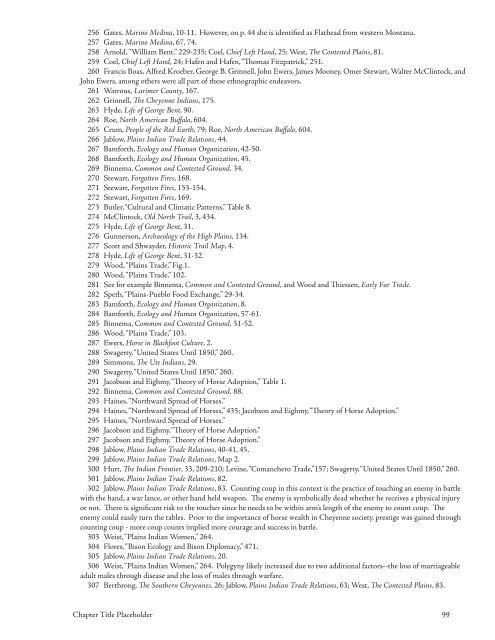People of the Poudre - Cache la Poudre National Heritage Area
People of the Poudre - Cache la Poudre National Heritage Area
People of the Poudre - Cache la Poudre National Heritage Area
Create successful ePaper yourself
Turn your PDF publications into a flip-book with our unique Google optimized e-Paper software.
256 Gates, Marino Medina, 10-11. However, on p. 44 she is identified as F<strong>la</strong><strong>the</strong>ad from western Montana.257 Gates, Marino Medina, 67, 74.258 Arnold, “William Bent,” 229-235; Coel, Chief Left Hand, 25; West, The Contested P<strong>la</strong>ins, 81.259 Coel, Chief Left Hand, 24; Hafen and Hafen, “Thomas Fitzpatrick,” 251.260 Francis Boas, Alfred Kroeber, George B. Grinnell, John Ewers, James Mooney, Omer Stewart, Walter McClintock, andJohn Ewers, among o<strong>the</strong>rs were all part <strong>of</strong> <strong>the</strong>se ethnographic endeavors.261 Watrous, Larimer County, 167.262 Grinnell, The Cheyenne Indians, 175.263 Hyde, Life <strong>of</strong> George Bent, 90.264 Roe, North American Buffalo, 604.265 Crum, <strong>People</strong> <strong>of</strong> <strong>the</strong> Red Earth, 79; Roe, North American Buffalo, 604.266 Jablow, P<strong>la</strong>ins Indian Trade Re<strong>la</strong>tions, 44.267 Bamforth, Ecology and Human Organization, 42-50.268 Bamforth, Ecology and Human Organization, 45.269 Binnema, Common and Contested Ground, 34.270 Stewart, Forgotten Fires, 168.271 Stewart, Forgotten Fires, 153-154.272 Stewart, Forgotten Fires, 169.273 Butler, “Cultural and Climatic Patterns,” Table 8.274 McClintock, Old North Trail, 3, 434.275 Hyde, Life <strong>of</strong> George Bent, 31.276 Gunnerson, Archaeology <strong>of</strong> <strong>the</strong> High P<strong>la</strong>ins, 134.277 Scott and Shwayder, Historic Trail Map, 4.278 Hyde, Life <strong>of</strong> George Bent, 31-32.279 Wood, “P<strong>la</strong>ins Trade,” Fig.1.280 Wood, “P<strong>la</strong>ins Trade,” 102.281 See for example Binnema, Common and Contested Ground, and Wood and Thiessen, Early Fur Trade.282 Speth, “P<strong>la</strong>ins-Pueblo Food Exchange,” 29-34.283 Bamforth, Ecology and Human Organization, 8.284 Bamforth, Ecology and Human Organization, 57-61.285 Binnema, Common and Contested Ground, 51-52.286 Wood, “P<strong>la</strong>ins Trade,” 103.287 Ewers, Horse in B<strong>la</strong>ckfoot Culture, 2.288 Swagerty, “United States Until 1850,” 260.289 Simmons, The Ute Indians, 29.290 Swagerty, “United States Until 1850,” 260.291 Jacobson and Eighmy, “Theory <strong>of</strong> Horse Adoption,” Table 1.292 Binnema, Common and Contested Ground, 88.293 Haines, “Northward Spread <strong>of</strong> Horses.”294 Haines, “Northward Spread <strong>of</strong> Horses,” 435; Jacobson and Eighmy, “Theory <strong>of</strong> Horse Adoption.”295 Haines, “Northward Spread <strong>of</strong> Horses.”296 Jacobson and Eighmy, “Theory <strong>of</strong> Horse Adoption.”297 Jacobson and Eighmy, “Theory <strong>of</strong> Horse Adoption.”298 Jablow, P<strong>la</strong>ins Indian Trade Re<strong>la</strong>tions, 40-41, 45.299 Jablow, P<strong>la</strong>ins Indian Trade Re<strong>la</strong>tions, Map 2.300 Hurt, The Indian Frontier, 33, 209-210; Levine, “Comanchero Trade,”157; Swagerty, “United States Until 1850,” 260.301 Jablow, P<strong>la</strong>ins Indian Trade Re<strong>la</strong>tions, 82.302 Jablow, P<strong>la</strong>ins Indian Trade Re<strong>la</strong>tions, 83. Counting coup in this context is <strong>the</strong> practice <strong>of</strong> touching an enemy in battlewith <strong>the</strong> hand, a war <strong>la</strong>nce, or o<strong>the</strong>r hand held weapon. The enemy is symbolically dead whe<strong>the</strong>r he receives a physical injuryor not. There is significant risk to <strong>the</strong> toucher since he needs to be within arm’s length <strong>of</strong> <strong>the</strong> enemy to count coup. Theenemy could easily turn <strong>the</strong> tables. Prior to <strong>the</strong> importance <strong>of</strong> horse wealth in Cheyenne society, prestige was gained throughcounting coup - more coup counts implied more courage and success in battle.303 Weist, “P<strong>la</strong>ins Indian Women,” 264.304 Flores, “Bison Ecology and Bison Diplomacy,” 471.305 Jablow, P<strong>la</strong>ins Indian Trade Re<strong>la</strong>tions, 20.306 Weist, “P<strong>la</strong>ins Indian Women,” 264. Polygyny likely increased due to two additional factors--<strong>the</strong> loss <strong>of</strong> marriageableadult males through disease and <strong>the</strong> loss <strong>of</strong> males through warfare.307 Berthrong, The Sou<strong>the</strong>rn Cheyennes, 26; Jablow, P<strong>la</strong>ins Indian Trade Re<strong>la</strong>tions, 63; West, The Contested P<strong>la</strong>ins, 83.Chapter Title P<strong>la</strong>ceholder 99


